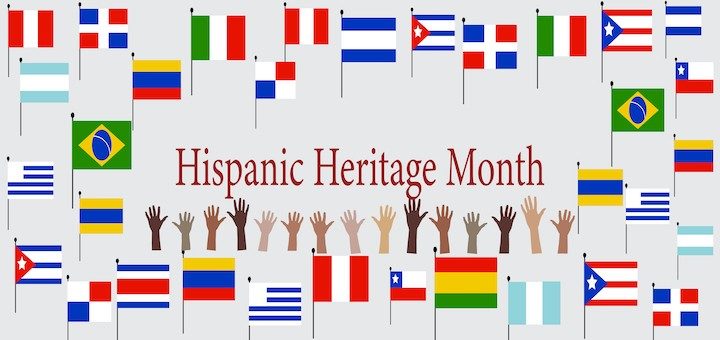Tracing the Cultures of Hispanic Americans

Updated August, 2024. National Hispanic Heritage Month stretches back to 1988 when Ronald Reagan signed it into law. (For the previous 20 years the annual observation had lasted a week.) The month begins on September 15, commemorating the beginning of the Mexican War for Independence in 1810, and runs through October 15.
Today teachers and students throughout the US can recognize the achievements and the challenges of Hispanic and Latino Americans across content areas. Several federal agencies provide resources. A 2018 National Archives blog post by Jessica Kratz, The Significance of Hispanic Heritage Month | El Significado del Mes de la Herencia Hispana, provides an overview of the law’s impact and links to President Johnson’s 1968 proclamation.
The National Park Service points out that the month honors both Hispanic and Latinx Americans, noting that “Hispanic refers to a person who is from, or a descendant of someone who is from, a Spanish-speaking country. Latino/a or Latinx refers to a person who is from, or a descendant of someone who is from, a country in Latin America.” The NPS also offers brief biographies of several persons across centuries.
See Vanessa Romo’s 2021 NPR post, Yes, We’re Calling It Hispanic Heritage Month And We Know It Makes Some Of You Cringe, for more background on the use of Hispanic, derived from Spanish, and the need to include the history of Latino peoples during Hispanic Heritage Month and throughout the year. (For use of the term Latinx instead of Latino/a, see this 2020 post by Pew Research: About One-in-Four U.S. Hispanics Have Heard of Latinx, but Just 3% Use It.)
The National Endowment for the Humanities shares links to NEH funded resources including documentaries, music, PD, and digital collections ranging from coast to coast. NEH’s most classroom-ready resource is EDSITEment’s Hispanic and Latino Heritage and History in the United States which offers guiding questions, history, landmarks, and lessons across content areas.
At Edutopia Rachel Fuhrman introduces 20th century Hispanic American civil rights activists in Incorporating Lessons on Activism During Hispanic Heritage Month.
¡Printing the Revolution! The Rise and Impact of Chicano Graphics, 1965 to Now is a recent exhibit the Smithsonian Institution’s Latino Center.
Among the Smithsonian Institution’s Learning Lab collections for Hispanic culture is a collection of resources from the National Portrait Gallery. By clicking on the information symbol, you can access details about many of the artists, politicians and others who are arranged by decade, from the 2010s back to the 1830s. SI also offers a collection of resources which goes beyond portraits.
The US Census Bureau’s 2024 Facts for Features commemorating Hispanic Heritage Month provides statistics on population growth since the 2010 Census, noting that at 18.9% percent, the Hispanic population is the second largest racial or ethnic group in the country. The report, available in English and Spanish, links to charts which could be useful for math classes. The Bureau also offers a 2022 page loaded with links to other government resources here.
Science Buddies provides bios of Hispanic and Latinx women and men have served in STEM fields.
Audio and Video Resources
You can listen to Scholastic’s “Celebrating Hispanic and Latine Heritage Month” here. In this Scholastic Reads episode, host Suzanne McCabe interviews beloved authors and illustrators including Sonia Manzano, author of Becoming Maria: Love and Chaos in the South Bronx; Pam Muñoz Ryan, author of Esperanza Rising and Mañanaland; and author Justin A. Reynolds and illustrator Pablo Leon, creators of the graphic novel, Miles Morales: Shock Waves. Scholastic also offers A Month of Ideas for Celebrating Hispanic Heritage centering on books for middle grades classes.
StoryCorps, the podcast series heard on NPR, hosted by the Library of Congress, and now offering animated videos, hosts several podcasts and videos presenting experiences and attitudes of Hispanic and Latinx Americans in its Historia collection, including Mi Abuela Panchita.
PBS Learning Media hosts brief history-centered videos and primary source sets. Find longer PBS videos and sets here. 40 Bilingual Kid-Friendly Tips, Crafts, Recipes and Books to Celebrate Hispanic Heritage All Year from PBS SoCal has resources for kids of all ages.
Hispanic Americans reflect on immigration, culture, and identity in this video from CBS This Morning from 2019.
“What Being Hispanic and Latinx Means in the United States,” presented by Fernanda Ponce at TEDxDeerfield in 2017, offers a brief history and tackles the harsh discrimination faced through generations. At about minute 10 she references former President Trump. She also notes that people identify with their country of origin rather than with the general Hispanic or Latinx label.


































